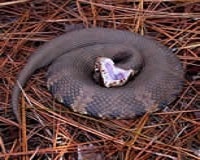 While the chances of dying from a snake bite in the United States are extremely low, it’s still important to know what the potential dangers are out there. This goes well beyond being a prepper or a survivalist, but it’s a simple part of being prepared whenever you explore a new area in snake country. While the chances of bites are always low, you need to know what’s out there and be particularly aware of the most potentially dangerous reptiles you might run into.
While the chances of dying from a snake bite in the United States are extremely low, it’s still important to know what the potential dangers are out there. This goes well beyond being a prepper or a survivalist, but it’s a simple part of being prepared whenever you explore a new area in snake country. While the chances of bites are always low, you need to know what’s out there and be particularly aware of the most potentially dangerous reptiles you might run into.
After all, you didn’t come to this website if you weren’t at least a bit worried about what type of venomous snakes might be out there. The good news is we’ve gathered all the information here for you so you don’t have to go searching for it. Keeping in mind all the various different definitions of “dangerous” when it comes to snakes native to the U.S. we have a Top 8 list with a specific explanation of why each one made it.
So scroll down and read on…and watch your step!
The Most Dangerous Snakes In The United States
One of the first things to mention here is that the term “dangerous” can be interpreted a wide array of different ways, and we make sure to take that into consideration with every single one of these. You will get the species of snake, the reason they are considered dangerous, and a rough estimation on the list of where they rank compared to each other (though depending on how you measure things, this is a very loose ranking).
While the United States certainly won’t have the same dangers that a place like India or Australia might (no king cobras around here), there are still plenty of snakes that can back a wallop in their bite. So read on to learn more and watch that step!
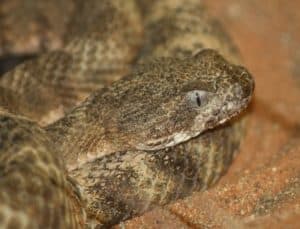 Tiger Rattlesnakes
Tiger Rattlesnakes
The tiger rattlesnake might be a bit of a surprise entry here, but there’s good reason for it. Only found in the state of Arizona in the United States, but also occurring in areas of northern Mexico, tiger rattlesnakes aren’t well known because they are very rarely found or stumbled upon. However, these snakes pack a really nasty surprise.
First of all, this is one of the rare species of rattlesnakes that are very ornery and aggressive. Most venomous snakes don’t want a confrontation. Much like the large cat they’re named after, these rattlers seem to thoroughly not give a crap. They are very territorial, they are very aggressive, and they aren’t afraid to jump to venomous bites really quickly – far more so than most species of rattlers.
Then there’s the venom itself. Only the deadly Mojave rattlesnake comes close to having the same toxic levels of venom as the tiger rattler. The tiger rattlers are known to have a really unique venom that causes both severe muscle rot as well as truly severe neurological issues. Their venom is considered the most toxic and dangerous of all rattlers although there are some Mojave rattlers with a dual-toxic venom that is right up there, as well.
The only thing preventing these snakes from being incredibly deadly is that they tend to be a bit smaller, meaning even though their venom is clearly one of the two most dangerous out of native U.S. snakes they don’t insert a large amount into a bite.
That being said, you still need to go to the hospital immediately if you suffer a bite from these nasty little guys because it doesn’t take much venom to thoroughly mess you up.
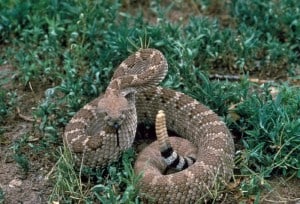 Diamondback Rattlesnakes
Diamondback Rattlesnakes
This is a bit of a cheat since it is combining two separate though closely related species: the eastern diamondback rattlesnake and the western diamondback rattlesnake, however they are similar enough that it makes a lot of sense to put them together in this one section. So why do diamondback rattlesnakes belong on this list?
There are several great reasons, including:
- The Eastern Diamondback rattlesnake gets larger than any other venomous snake in the United States
- The Western Diamondback rattlesnake is the second largest venomous snake in the United States
- Diamondbacks tend to be among the most aggressive of rattlesnakes – especially the Western Diamondbacks
- These snakes unleash massive amounts of venom when they bite
- More people in the U.S. die from diamondback rattlesnake bites than any other
These are pit vipers that get large, actually deserve the reputation for being territorial or aggressive that many venomous snakes have (even if they’re generally not), and because of their larger size they can insert a much larger dose of venom into their bites.
This makes them incredibly dangerous when they bite. By a pure measurement standpoint of snake bite deaths, diamondbacks are responsible for more deaths than any other U.S. species combined and in many years they are responsible for as many deaths as all other venomous snake bites combined.
So they definitely belong on this list.
 Mojave Rattlesnake
Mojave Rattlesnake
No one who lives in Mojave Rattlesnake habitat is surprised that they appear on this list. These snakes have a reputation for being nasty, dangerous, and even among herpetologists these rattlesnakes stick out because of the strange and unique nature of their venom. The Mojave is terrifying enough just based on attitude but once you learn more about the types of venom these snakes have, that fear can easily jump even a few notches higher.
The Mojave rattlesnake can mostly be found in parts of southern California, Nevada, and Arizona, all in desert regions, and also occasionally pops up in parts of New Mexico or west Texas, though most sightings there tend to be the Western Rattlesnake, which is often mistaken for the Mojave as the two species look incredibly similar.
The Mojave is notorious for being perhaps the most aggressive rattlesnake out there, one of the few that is willing to “strike first and ask questions later” and actively defend its territory against larger potential predators like humans. In other venomous snakes the venom is either hemotoxic (attacks the blood) or nuerotoxic (attacks the nervous system). Mojaves can be either or, making it tricky to treat a bite with the right anti-venom before massive damage is done. No matter which type of venom the Mojave rattler has (and there is no way to tell without lab testing), it will be among the most toxic and damaging of all rattlesnake venoms.
Then there’s the fact that there are increasing populations of Mojave Rattlesnakes whose venom has BOTH properties. Bites from them destroy everything: muscle, flesh, blood, nerves, nervous system – it’s just devastating and very resistant to traditional treatments.
No question this nasty guy belongs on the list – and might be the single most dangerous snake in the United States. Good thing it’s not more widespread or they would definitely fly up this list!
 Cottonmouths/Water Moccasins
Cottonmouths/Water Moccasins
Here is a snake that has a fearsome reputation for being incredibly aggressive and in many areas is outright feared. One thing that sets this pit viper apart is that they are distinctly a water snake. They have the ability to strike a person in water or out of water, and they are one of the few species that won’t run first at the sign of danger. The best way to describe the average water moccasin’s attitude is “stand your ground” and that means they are more than happy to put up very aggressive displays and strike if you don’t back off.
For people unlucky enough to dive onto one in a creek or discover them accidentally while going through the lakeside weeds, that usually means really bad news. These snakes are responsible for the overwhelming majority of non-rattlesnake related snake bite deaths in the United States, although that means they still trail rattlers.
They are closely related to copperheads although with a stronger venom. The bite is rarely fatal to a full grown adult who is healthy, but it can still do a major amount of damage to the bit limb and surrounding areas of the body.
Then there are the issues of multiple bites, allergic reactions, or the fact that water moccasin venom does seem to agitate any condition that already exists like a weakened immune system, heart issues, and other potential health problems. While they might not have the “killing power” of other venom, they are often found in isolated places and aren’t going to back down making them one of the more dangerous species to humans in the United States.
They might not be as aggressive as their reputation, but for most people who have had to tread lightly around them, it was close enough!
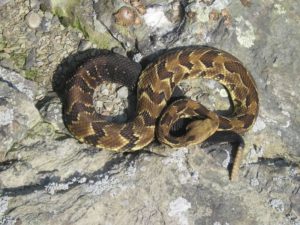 Timber Rattlesnake
Timber Rattlesnake
The timber rattlesnake is like several rattlesnakes on this list: the venom is potentially extremely toxic and dangerous but the fact so many populations of timber rattlers are isolated and small means they come into relatively little contact with people who often live nearby. When talking about the most dangerous venomous snakes in the States it’s worth noting that there are some parallel themes running here: one that makes this snake scary and the other that is actually reassuring.
The bad news? Timber rattlesnake venom is one of the nastiest of all the rattlesnake venoms. It’s not Mojave or Tiger, but it is right up there at the upper tier next level with diamondbacks. In addition to this, when a large timber rattler does commit to biting, it can absolutely unload massive amounts of venom into the bite.
The good news? Timber rattlers are known for having one of the mildest dispositions of all venomous snakes. They tend to be really laid back, slow to strike, and will absolutely take any opportunity to leave. Prime example: take a look at this large timber rattler in Indiana slowly making its way across the trail, not paying attention to people, moving along slowly like it doesn’t have a care in the world (VIDEO HERE).
That being said, still leave alone or deal with caution. These snakes have deadly venom, they will strike if they feel like they have to, and they are responsible for their fair share of the handful of deadly snake bite deaths each decade. While they’re among the least likely to cause issues with you relatively close by as long as you leave it alone, if they do strike it can easily be fatal so proceed carefully.
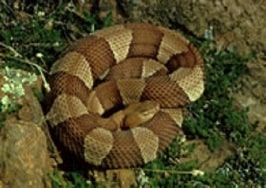
Copperheads
Copperheads are one of the least likely to be deadly on this list because their venom is frankly just much less potent than the other snakes on this list. In fact, most of the time an adult can suffer from a copperhead bite without antivenom and survive – though obviously that is not at all recommended for a variety of reasons.
So why do copperheads make this list?
Because they bite like crazy. Copperheads are the only venomous snake native to the United States whose instincts are to strike first anytime any potential threat comes within range.
Add in the fact their camouflage is absolutely insane in the wild (here’s the search for copperheads hidden in leaves on Google if you don’t believe me) and it is easy to see how many people could get bit BEFORE they even see the venomous copperhead for the first time.
This is why of the 7,000 to 9,000 venomous snake bites a year copperheads are responsible for the heavy majority. However they are very rarely fatal since the venom is weak. In most cases when death occurs it is because the person bit is already very sick, already has heart complications, or is hypersensitive to all snake venom and thus has an allergic reaction. In most those cases people refused immediate treatment, as well.
Because of the sheer number of bites and the fact venom is still venom, they make this list.
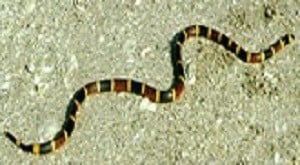 Coral Snakes
Coral Snakes
This is a pretty strong “in theory” type of entry. Coral snakes are the only venomous snake on this list that are not pit vipers, meaning they don’t have those dual fangs that make it easy to inject venom into people. They have a harder time breaking the skin to inject their venom but the venom itself of the coral snake is incredibly nasty.
So to start with the most common rumor/story, yes, the coral snake is a cousin to the incredibly dangerous cobras you find in Asia. From a pure toxicity standpoint, a major injection from a coral snake would be absolutely devastating. These snakes have enough venom to kill four or five grown adults, but most of their bites have little or not venom, especially at first strike.
That being said, the venom is incredibly toxic and there is another factor in play that could cause serious problems for anyone unlucky enough to get bit: there’s no more antivenom. It stopped being made in 2010 because so few people were ever bit. In fact there’s only one recorded death since 1960.
The venom is devastating and dangerous – but the likelihood of seeing one of these or getting bit is so small. That being said – treat any coral snake you do see with the ultimate respect: by leaving it the hell alone.
Why We Recommend Protection Vs. “Treatment”
While I always loved the idea of a snake bite kit, the ability to quickly treat a snake bite and increase your chances of health and survival, unfortunately the truth is that snake bite kits just don’t work. That’s the consensus of the experts, that’s the overwhelming evidence in studies that have been done looking at these. While snake bite kits could still be useful for pulling out bee stingers and often have alcohol pads or small bandage that can be useful for other treatment issues but as for a direct way to remove venom from a snake bite, it doesn’t work.
As much as I really wished I could support these kits, they’re just not the type of tool that’s going to help the way that they are advertised. Any evidence for them are from second hand stories or accounts, none of which take into consideration dry bites or the possibility they ended up fine in spite of the treatment with a snake bit kit and not because of it.
Because of these new studies we’re actually moving away from this site after a final post which once done should be found HERE: Why Snake Bite Kits Don’t Work.
In Conclusion
While spending a lot of time outdoors, even in snake country, should always be encouraged because there is relatively little chance of getting bit by a venomous snake. However, you still want to make sure you are going to be prepared for the worst case scenario. Knowledge is power and understanding what snakes are potentially going to be in the area and their habits can go a long way to helping you avoid them – and exercise the kind of caution around potential snake habitat that can help you avoid any potential bites.
This is the list of the snakes you generally need to worry about most in the United States. By preparing for them you are going to be more likely to come out of any situation in good shape.